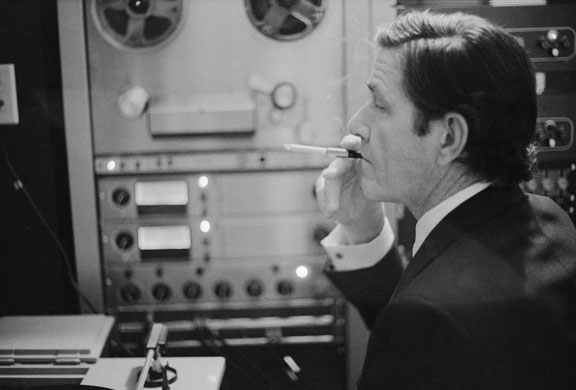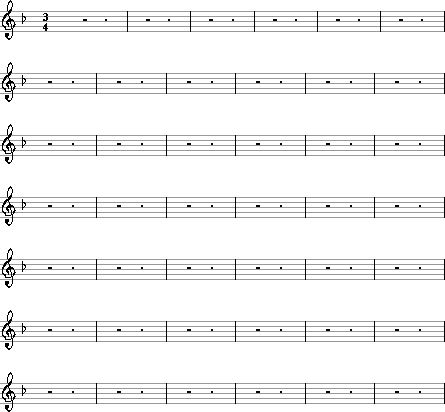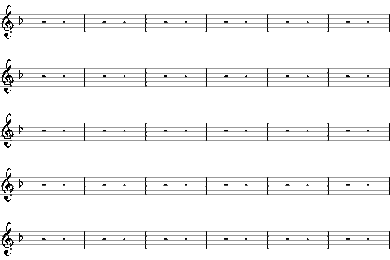Today (Monday December 12) sees the release of Cage Against The Machine’s version of the John Cage piece 4’33", composed in 1952. Among the "supergroup" who assembled in the studio for the recording were Orbital, The Kooks, Billy Bragg, UNKLE, Suggs, Enter Shikari and Imogen Heap. Not exactly an A-list there but then, all they were required to do was turn up. XFM DJ Eddy Temple-Morris, who co-ordinated the thing, told the BBC, "We’re going to plug everybody in. We’re going to have a drum kit with a few drummers, some bass players, some guitarists. I don’t know what the noise will be. I imagine there will be the tweak of a leather jacket, a cough, a snigger, a muffled laugh. You’ll hear whatever happens in that room at the time. That’s the performance."
Oh, yes. There will be muffled laughs all right – the same ones that resounded around the Barbican Hall in 2004 when 4’33" was performed by the BBC Symphony orchestra, who couldn’t resist turning the thing into a comedy piece, with lots of barely contained grinning and antics from the conductor. It was a failure, a deliberately lost battle to keep a straight face – they were overcome by a very English self-consciousness and impulse to lay low all subject matter, especially the supposedly pretentious, the artsy and the fartsy, with an all-purpose, half-arsed, coloured rimmed glasses, chortling levity.
The CATM release, which comes on the back of a Facebook campaign currently boasting over 70,000 supporters, is inspired by last year’s campaign to get Rage Against The Machine to the Xmas Number One spot, and to the same end – to displace the X Factor entry, thwart the villainous Simon Cowell and send him and his selected karaoke, stooge and his stupid centre parting packing to number two. It was preceded by a simultaneous audiovisual performance by a global orchestra, conducted live by Bob Dickinson via video link, in support of the campaign. All proceeds will go to charity, including the British Tinnitus Association. All well and good. But will this be the latest in a line of wilful misunderstandings of what John Cage rightly considered his most important work?
Versions of, and tributes to 4’33" are not new. They have been perpetrated by everyone from Zappa to Ciccone Youth, to The Fast Show and Mike Batt, the Wombles man. Staff of The Guardian performed an amusing version of the piece back in 2004. Don’t you wish you had been there? Me neither. Batt’s version of the piece, included on a 2002 album was called "A Minute’s Silence" and credited to Batt/Cage. At the time, a story went up that he had been sued by John Cage’s estate for this supposed infringement before they made a very public out of court settlement. However, Batt recently revealed that the whole thing had been a scam. He had merely donated £1000 to the John Cage Foundation. Cheap publicity indeed.
4’33" as joke is now commonplace – the sound system only has to fail at a pub quiz nowadays for some wag to shout out "John Cage". Mea culpa, that wag was probably me, several times in the past, but be sure that, especially after this Christmas, that joke will be made many, many times in the future and will slowly die the death of a thousand cunts, as the Chinese would say.

However, one thing John Cage was very clear about was that the piece wasn’t intended as a laughing matter. "I didn’t wish it to appear, even to me, as something easy to do or as a joke. I wanted to mean it utterly and be able to live with it," he said.
Cage had incorporated protracted sequences of non-performance into his work before, in pieces like Sonata and Interludes and The Concerto For Prepared Piano And Orchestra, which both made use of extended pauses. He had conceived of a piece in 1947 entitled "A Silent Prayer", which he envisaged comprising nothing but "uninterrupted silence" and which he planned to sell to a Muzak corporation. He’d been impressed too by Robert Rauschenberg’s series of blank canvasses, in which the subject matter was the moving shadows of those who stood in front of them. However, the epiphany which gave rise to 4’33" occurred in 1951, when Cage visited the anechoic chamber at Harvard University, a room fully soundproofed externally and with all echoes suppressed internally. Cage anticipated that in such a room he would experience absolute silence. However, he was conscious of two audible drones, high and low. These, the engineer in charge told him, were the sounds of his own body. The high one was his nervous system in operation, the low one his blood in circulation. "Until I die there will be sounds," concluded Cage. "And they will continue following my death. One need not fear about the future of music."
Here, then, is the significance of 4’33" – that it is impossible for humans to experience true silence – that there is, to all intents and purposes, no such thing as silence, except as an abstract notion. That’s why it’s called 4’33" – a duration of time – and not "Silence". In fairness, it’s clear from Cage Against The Machine’s co-ordinator Eddy Temple-Morris’s description of their performance that he has grasped this point. Others have not. On the BBC website and in The Observer recently, as well as in some text books, the mistake has been repeated, as it so often is, that the piece comprises 4 minutes and 33 seconds of silence. It does not. In the absence of musical performance, it consists of whatever noises occur in its stead – a cough, the heating system of a concert hall, the distant sound of traffic or aircraft, the creak of the architecture. Ambient in extremis.
This isn’t whimsy. This isn’t a conceptual prank. This is serious, but not in the grave sense the piece is also associated with – the equivalent of the minute’s silence on Remembrance Day, for example (John Lennon made this mistake in his own, Cage tribute on his experimental album Life With The Lions). It’s serious because it gets right to the heart of the avant garde project of the last century as a whole, as expressed in Dada, in Picasso’s pasting bits of Le Figaro onto his canvasses, Marcel Duchamp’s urinal "readymade", in the sirens that wail through the orchestral works of the composer Edgard Varese like Ameriques, in Futurist Luigi Russolo’s Art Of Noises manifesto – to collapse the walls between art and life, in this case to extend the notion of what is admissible as music and what is not to . . . everything. This was an idea that would have confounded the great musical masters of the 19th century and previously, whose overarching assumptions would come crashing down in the early part of the 20th. In this respect, 4’33", ironically, is closer to "noise" music than anything else.
Sadly, for reasons I attempted to explore in my book Fear Of Music: Why People Get Rothko But Don’t Get Stockhausen, the radical music, if not the radical art of 60, 70 even 100 years ago is still greeted with stupefied and amused misapprehension on the rare occasions when it finds a mass audience.
Perhaps this is one of those rare occasions. It’s probably too much to expect that any success for this single will function as a portal for a wider audience into experimental music as a whole, too much to expect that it won’t be a cue for every jowl-quivering halfwit across the media to don their funny hats and make like whirling bow ties with their jibes at the single’s expense. Ooh, Chris Evans, will you able to resist?
But I’ll be one of those rooting for CATM, as I did RATM last year, more or less entirely out of antipathy to Simon Cowell. Like 4’33" and unlike Eurovision or Strictly Come Dancing, X Factor is no joke. It sits at precisely the opposite extreme on the cultural spectrum from Cage’s work. It is the ultimate in 21st century unvolution, in brutal apres garde tyranny. If 4’33" says everything is admissible as music, X Factor says virtually nothing is, except via the originality-exterminating sifting process established on the show, in which all that is allowed through are the cliched emotional stylings of those carefully selected yet easily dispensable members of the public who murder ballads with the appropriate display of "star quality" that best meets Cowell’s liking. In an age in which pop has become the equivalent of the closing chant of "Hey Jude" fading out forever, in which X Factor has successfully altered the very gravity and oxygen levels of the genre to ruinous effect, any sort of opposition to its joyless, stifling, onward march is welcome. So go, Cage Against The Machine. But please. No. Fucking. Giggling.



